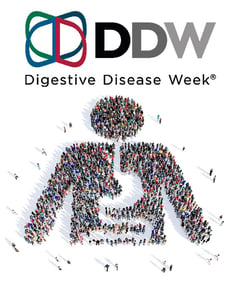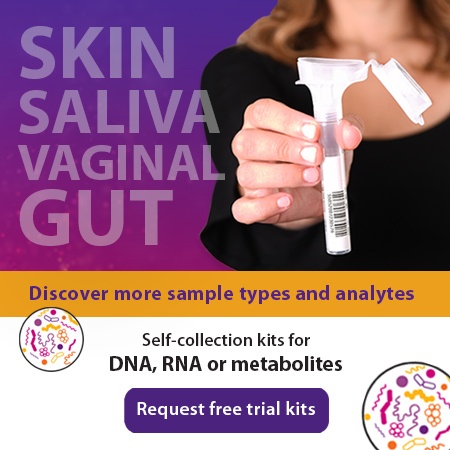2018-07-05
 Digestive Disease Week 2018 (DDW2018) was another successful conference with over 450 sessions presented by invited speakers and abstract authors. The interest in how the microbiome could potentially impact digestive diseases grew even more this year as compared to past conferences, with more talks dedicated to the microbiome. Many of the talks were so popular they required overflow space in the hallways to accommodate all the interested audience members. You could feel the energy of new ideas being uncovered and knowledge being shared, and I felt privileged to be able to take part this year with a few of my fellow DNA Genotek colleagues.
Digestive Disease Week 2018 (DDW2018) was another successful conference with over 450 sessions presented by invited speakers and abstract authors. The interest in how the microbiome could potentially impact digestive diseases grew even more this year as compared to past conferences, with more talks dedicated to the microbiome. Many of the talks were so popular they required overflow space in the hallways to accommodate all the interested audience members. You could feel the energy of new ideas being uncovered and knowledge being shared, and I felt privileged to be able to take part this year with a few of my fellow DNA Genotek colleagues.
With so many thought-provoking sessions to choose from, I certainly was not able to attend them all. With a particular interest in the gut microbiome, I wanted to share some of my highlights.
1. Continuing Trend: Beyond Bacteria
In last year’s blog post about the highlights from DDW2017 we noted the rise in interest in the role of phages in digestive diseases. Well, the expansion of the field to encompass more than the bacteria residing within the human gut continued this year. At DDW2018 there was more of a focus on the contribution of fungus and yeast to human health and disease, in addition to viruses and phages.
Tao Zuo’s presentation Fecal Microbiota Transplantation Alters the Gut Mycobiome (fungome) which Correlates with Treatment Outcome in Clostridium Difficile Infection included an impressive amount of data and focused on the role of enteric fungal dysbiosis in Clostridium difficile infection (CDI). One of his conclusions supported the importance of restoring both fungal and bacterial microbiota in fecal microbiota transplantation efficacy treating CDI.
Similarly, Olabisi Coker’s presentation Enteric Fungi Compositional and Ecological Dysbiosis in Colorectal Cancer also looked beyond bacterial dysbiosis for a human disease; specifically colorectal carcinogenesis (CRC). The authors looked at the fungal microbiota, bacterial microbiome, as well as a many other diverse ecological networks, to understand the role these diverse organisms play in this complex disease. Furthermore, she proposed a potential use for fungal markers in the diagnosis of CRC in the future.
2. Multi-omics and Evolving Technologies
Unsurprisingly in a rapidly evolving field, significant technology development has been driving a lot of new discovery. In order to characterize or understand a human disease or biological response to an intervention, it’s necessary to conduct large cohort studies and to collect many different biological samples. These samples are run through high-throughput analysis and generate huge databases, which are needed to see a statistically significant response. By combining genomic sequencing, mass spectroscopy (MS) for deep immune profiling, proteomics and metabolomics, this field is moving towards cross-platform integration of data through computational methods and deep learning algorithms, including artificial intelligence. Genetic sequencing tends to functions as the foundation of these studies with multi-omics data layered over to provide a more comprehensive view of the very complex interactions between the host and resident microbial populations. It seems more and more a microbiome researcher requires access to a variety of analysis technologies and the academic and industry experts to help analyze and combine all of the resultant data sets. Hopefully researchers in the field continue to nurture the collaborative nature of these multi-omics studies.
3. Focus on Human Studies and Interventions
One of the major goals in gut microbiome research is to develop new diagnostics and therapeutics which requires the field to translate basic research to clinical studies. This push for more human research studies and human intervention studies was a commonly echoed theme this year.
Why does there need to be a greater investment in human research? A lot of the early work in this field was conducted in modest-sized, population-based observational studies or in animal models. Animal models -- where diet, environment, genetics and other potential confounding variables can be regulated -- allow for cause and effect relationships to be determined. The constant question an animal researcher faces is ‘How relevant are the results derived from animal models to actual humans living in the real world?’
In a presentation by Gary Wu, Designing an Informative Microbiome Clinical Study, he highlighted some key microbiome study designs and considerations to optimize research:
One interesting discussion point was the use of small studies of a well-defined and characterized human population to discover trends or correlations between the microbiome and human health. The discovered correlations can then be modeled in an easily controlled system, like tissue explants, cell culture or animals, to determine the mechanism of action. The benefit is that you know a correlation exists in a human subpopulation before you spend a lot of time and money diving into the mechanism or conducting very large longitudinal studies.
Speaking of longitudinal studies, or more specifically prospective studies, a major benefit of this type of study is that subjects can act as their own baseline and control, which avoids the whole issue of inter-subject variability causing noise. Since research is showing that a person’s microbiome can change daily, and be influenced by things like diet, exercise, stress and sleep, it becomes even more important to collect multiple samples overtime to help weed through the normal cyclical changes in the microbiome to reach the actionable insights that could spark the next big microbiome discovery.
These are the 3 trends that resonated for me at DDW this year. What were some of your favorite moments from DDW2018 or your thoughts on my three highlights?


